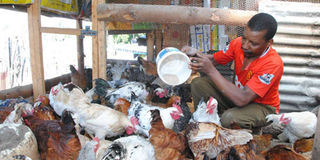Understanding cannibalism in poultry and how to curb it

A farmer feeds his chicken in a farm in Elburgon. Beak trimming can be done as a preventive measure to poultry cannibalism. FILE PHOTO | NMG
What you need to know:
- Light breed birds such as the leghorns are more susceptible to cannibalism than other heavier breeds because of their.
- Provide the birds with proper nutrients according to their age, needs and type. As the birds grow, their demand for protein also increases hence it should be adjusted in their feeds.
- Anything that can cause injury to the birds like cut wires and wood splinters should be removed and the house repaired.
All birds kept together should be of the same age and colour. - Control external parasites like lice and mites that may cause itching and loss of feathers
Cannibalism is a problem associated with large poultry flocks where the birds peck, tear and consume skin, tissues and organs of others in the same flock.
This is observed in all types of housing systems where birds are kept in closed confinement.
The bird’s show this behaviour when they are crowded or feel restricted and can occur in birds of all ages and of different species.
Light breed birds such as the leghorns are more susceptible to cannibalism than other heavier breeds because of their flighty nature and hypersensitivity to environmental factors.
After dominant relationships have been established, the less dominant birds may be pecked until they die.
This causes stress leading to a drop in egg production as non-aggressive birds spend most of the time running away from the aggressive flock and not feeding.
There are behaviours that could indicate birds with potential cannibalism tendencies. These include;
• Toe picking in chicks.
• Feather pulling in older birds.
• Vent picking in older birds.
• A dominant bird pecking at a more submissive member of the flock.
• Mutual pecking where birds in close proximity peck at each other.
Causes of cannibalism in a flock
There are several reasons why cannibalism occurs in birds. These are:
Overcrowding the birds such that they are restricted from exhibiting normal behaviour like dust bathing or limited access to perches or nesting boxes.
Change in diet to a less preferred feed.
Injured and bleeding birds that are left in the flock.
Deficiencies in diet; calcium, sodium or protein.
Keeping birds of different ages and colour together.
External parasites like lice and mites that stimulate feather pecking.
Bright light - photosensitisation programmes meant to stimulate early laying.
Weak diseased birds tend to be pecked on
Normal pecking behaviour among pen mates that develops to serious episodes.
While laying large eggs, some birds may have prolapsed cloaca which attracts other birds to peck on.
Boredom can cause birds to start pecking on each other
How to prevent cannibalism in a flock
Cannibalism is a management problem that can be prevented:
The birds should not be overcrowded as this prevents them from accessing feeders and drinkers leading to the less dominant flock members being under weight and hence victims of cannibalism. A space of 2 square ft per layer bird is sufficient.
Provide the birds with proper nutrients according to their age, needs and type. As the birds grow, their demand for protein also increases hence it should be adjusted in their feeds.
A diet deficient in protein may lead to feather pecking and cannibalism.
Even though light is important in a chicken house, the optimal amount should be such that one can read a copy of their Seeds of Gold at the darkest point (about 0.5 to 1.0 foot candles).
Photostimulation programmes should be delayed to 20 weeks of age. The laying boxes should be dark to provide a safe place for laying hence preventing exposure of the cloaca to pecking birds and also to prevent development of egg pecking/eating.
They should be covered with a dark clothing/paper to minimise entry of light.
Any injured/weak birds should be isolated as the blood oozing from them may stimulate cannibalism.
Anything that can cause injury to the birds like cut wires and wood splinters should be removed and the house repaired.
All birds kept together should be of the same age and colour.
Keep the birds busy by placing objects in the cage to provide interest, for example by hanging vegetables and placing seeds on the ground to keep them busy going through litter looking for the seeds.
Place perches to help birds perch and escape aggressive ones.
Control external parasites like lice and mites that may cause itching and loss of feathers
Beak trimming can be done as a preventive measure to cannibalism.
The procedure should be done by trained personnel as over-trimming may lead to injuries and could affect the birds’ ability to feed.
When managing cannibalism in birds, always supplement with Stressmix in drinking water for at least five days.





